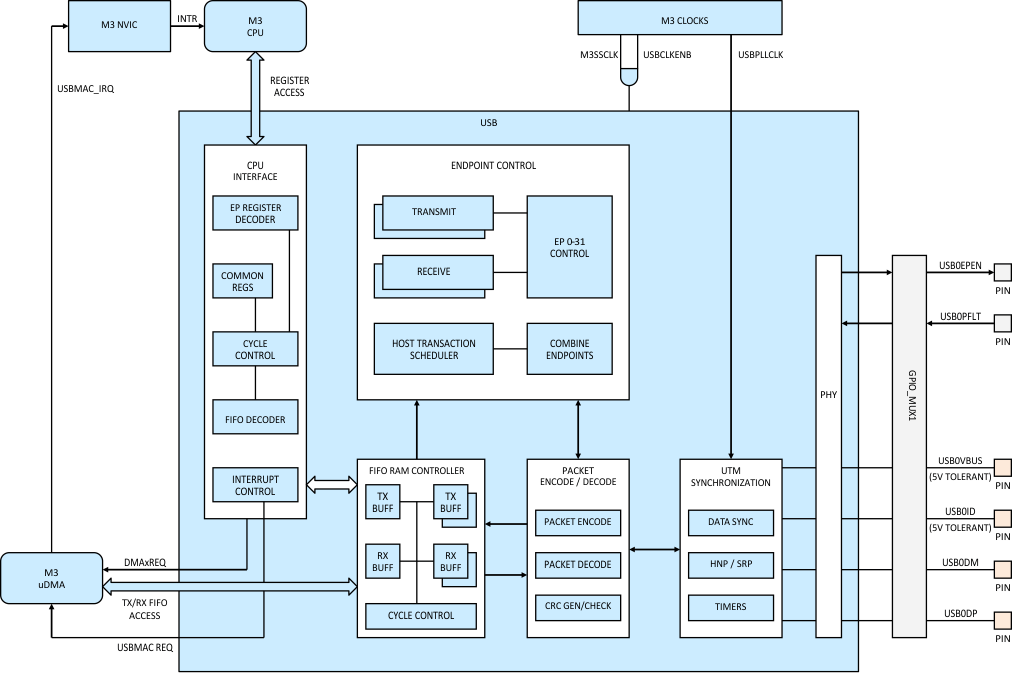SPRS825F October 2012 – June 2020 F28M36H33B2 , F28M36H53B2 , F28M36P53C2 , F28M36P63C2
PRODUCTION DATA.
- 1Device Overview
- 2Revision History
- 3Device Comparison
- 4Terminal Configuration and Functions
-
5Specifications
- 5.1 Absolute Maximum Ratings
- 5.2 ESD Ratings – Commercial
- 5.3 Recommended Operating Conditions
- 5.4 Power Consumption Summary
- 5.5 Electrical Characteristics
- 5.6 Thermal Resistance Characteristics for ZWT Package (Revision 0 Silicon)
- 5.7 Thermal Resistance Characteristics for ZWT Package (Revision A Silicon)
- 5.8 Thermal Design Considerations
- 5.9
Timing and Switching Characteristics
- 5.9.1 Power Sequencing
- 5.9.2
Clock Specifications
- 5.9.2.1 Changing the Frequency of the Main PLL
- 5.9.2.2
Input Clock Frequency and Timing Requirements, PLL Lock Times
- Table 5-5 Input Clock Frequency
- Table 5-7 Crystal Oscillator Electrical Characteristics
- Table 5-8 X1 Timing Requirements - PLL Enabled
- Table 5-9 X1 Timing Requirements - PLL Disabled
- Table 5-10 XCLKIN Timing Requirements - PLL Enabled
- Table 5-11 XCLKIN Timing Requirements - PLL Disabled
- Table 5-12 PLL Lock Times
- 5.9.2.3 Output Clock Frequency and Switching Characteristics
- 5.9.2.4 Internal Clock Frequencies
- 5.9.3 Timing Parameter Symbology
- 5.9.4 Flash Timing – Master Subsystem
- 5.9.5 Flash Timing – Control Subsystem
- 5.9.6 GPIO Electrical Data and Timing
- 5.9.7 External Interrupt Electrical Data and Timing
- 5.10
Analog and Shared Peripherals
- 5.10.1 Analog-to-Digital Converter
- 5.10.2 Comparator + DAC Units
- 5.10.3 Interprocessor Communications
- 5.10.4
External Peripheral Interface
- 5.10.4.1 EPI General-Purpose Mode
- 5.10.4.2 EPI SDRAM Mode
- 5.10.4.3 EPI Host Bus Mode
- 5.10.4.4
EPI Electrical Data and Timing
- Table 5-52 EPI SDRAM Interface Switching Characteristics (see , , and )
- Table 5-53 EPI Host-Bus 8 and Host-Bus 16 Interface Switching Characteristics (see , , , and )
- Table 5-54 EPI Host-Bus 8 and Host-Bus 16 Interface Timing Requirements (see and )
- Table 5-55 EPI General-Purpose Interface Switching Characteristics (see )
- Table 5-56 EPI General-Purpose Interface Timing Requirements (see and )
- 5.11
Master Subsystem Peripherals
- 5.11.1 Synchronous Serial Interface
- 5.11.2 Universal Asynchronous Receiver/Transmitter
- 5.11.3 Cortex-M3 Inter-Integrated Circuit
- 5.11.4 Cortex-M3 Controller Area Network
- 5.11.5 Cortex-M3 Universal Serial Bus Controller
- 5.11.6 Cortex-M3 Ethernet Media Access Controller
- 5.12
Control Subsystem Peripherals
- 5.12.1 High-Resolution PWM and Enhanced PWM Modules
- 5.12.2 Enhanced Capture Module
- 5.12.3 Enhanced Quadrature Encoder Pulse Module
- 5.12.4 C28x Inter-Integrated Circuit Module
- 5.12.5 C28x Serial Communications Interface
- 5.12.6 C28x Serial Peripheral Interface
- 5.12.7
C28x Multichannel Buffered Serial Port
- 5.12.7.1
McBSP Electrical Data and Timing
- 5.12.7.1.1 McBSP Transmit and Receive Timing
- 5.12.7.1.2
McBSP as SPI Master or Slave Timing
- Table 5-81 McBSP as SPI Master or Slave Timing Requirements (CLKSTP = 10b, CLKXP = 0)
- Table 5-82 McBSP as SPI Master or Slave Switching Characteristics (CLKSTP = 10b, CLKXP = 0)
- Table 5-83 McBSP as SPI Master or Slave Timing Requirements (CLKSTP = 11b, CLKXP = 0)
- Table 5-84 McBSP as SPI Master or Slave Switching Characteristics (CLKSTP = 11b, CLKXP = 0)
- Table 5-85 McBSP as SPI Master or Slave Timing Requirements (CLKSTP = 10b, CLKXP = 1)
- Table 5-86 McBSP as SPI Master or Slave Switching Characteristics (CLKSTP = 10b, CLKXP = 1)
- Table 5-87 McBSP as SPI Master or Slave Timing Requirements (CLKSTP = 11b, CLKXP = 1)
- Table 5-88 McBSP as SPI Master or Slave Switching Characteristics (CLKSTP = 11b, CLKXP = 1)
- 5.12.7.1
McBSP Electrical Data and Timing
-
6Detailed Description
- 6.1 Memory Maps
- 6.2 Identification
- 6.3 Master Subsystem
- 6.4 Control Subsystem
- 6.5 Analog Subsystem
- 6.6 Master Subsystem NMIs
- 6.7 Control Subsystem NMIs
- 6.8 Resets
- 6.9 Internal Voltage Regulation and Power-On-Reset Functionality
- 6.10 Input Clocks and PLLs
- 6.11 Master Subsystem Clocking
- 6.12 Control Subsystem Clocking
- 6.13 Analog Subsystem Clocking
- 6.14 Shared Resources Clocking
- 6.15 Loss of Input Clock (NMI Watchdog Function)
- 6.16 GPIOs and Other Pins
- 6.17 Emulation/JTAG
- 6.18 Code Security Module
- 6.19 µCRC Module
- 7Applications, Implementation, and Layout
- 8Device and Documentation Support
- 9Mechanical, Packaging, and Orderable Information
5.11.5.1 Functional Description
The USB controller provides full OTG negotiation by supporting both the SRP and the HNP. The SRP allows devices on the B side of a cable to request the A-side devices' turn on VBUS. The HNP is used after the initial session request protocol has powered the bus and provides a method to determine which end of the cable will act as the Host controller. When the device is connected to non-OTG peripherals or devices, the controller can detect which cable end was used and provides a register to indicate if the controller should act as the Host controller or the Device controller. This indication and the mode of operation are handled automatically by the USB controller. This autodetection allows the system to use a single A/B connector instead of having both A and B connectors in the system, and supports full OTG negotiations with other OTG devices.
In addition, the USB controller provides support for connecting to non-OTG peripherals or Host controllers. The USB controller can be configured to act as either a dedicated Host or Device, in which case, the USB0VBUS and USB0ID signals can be used as GPIOs. However, when the USB controller is acting as a self-powered Device, a GPIO input must be connected to VBUS and configured to generate an interrupt when the VBUS level drops. This interrupt is used to disable the pullup resistor on the USB0DP signal.
NOTE
When the USB is used, the system clock frequency (SYSCLK) must be at least 20 MHz.
 Figure 5-34 USB
Figure 5-34 USB